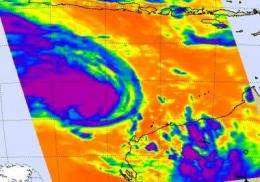NASA infrared satellite data see an intensifying Tropical Storm Dianne

Infrared satellite data from NASA's Aqua satellite reveal that Tropical Storm Dianne is getting organized off the coast of Western Australia today.
NASA's Atmospheric Infrared Sounder (AIRS) infrared imagery suggests that Dianne's center of circulation is consolidating and getting organized. There are bands of thunderstorms wrapping into the center of the storm, indicating strengthening is occurring. The AIRS instrument flies aboard NASA's Aqua satellite. The AIRS infrared image of Tropical Storm Dianne from Feb. 17 at 06:05 UTC (1:05 a.m. EST) showed a large area of strong convection and powerful thunderstorms. Those cloud top temperatures in the strongest thunderstorms were as cold as or colder than -63F/-52C.
Microwave imagery from the Advanced Microwave Sounding Unit (AMSU), a multi-channel microwave radiometer installed on meteorological satellites, even indicated that an eye had formed in Dianne's center.
Tropical Storm Dianne is on a southerly track through the Southern Indian Ocean and is currently forecast to stay off shore and away from Western Australia.
At 1500 UTC (10 a.m. EST) Tropical Cyclone Dianne had maximum sustained winds near 55 knots (63 mph/101 kmh). Tropical storm-force winds extend about 60 miles from the center. Dianne was centered about 260 nautical miles (299 miles/281 km) northwest of Learmonth, Australia near 19.0 South and 110.7 East. It was creeping to the southeast at 1 knot (1 mph/2 kmh). Dianne continues to generate waves as high as 19 feet (~6 meters) in that area of the Southern Indian Ocean.
The Joint Typhoon Warning Center (JTWC) expects Dianne to stop meandering and start moving south on Feb. 18 while intensifying. The JWTC does expect that Dianne will remain well west of the Australian coast. However, there are warnings posted for Western Australia. A Cyclone Warning is currently in effect for coastal areas from Exmouth to Coral Bay and a Cyclone Watch is in effect for coastal areas from Onslow to Exmouth and Coral Bay to Overlander Roadhouse, including Carnarvon and Denham.
Provided by NASA's Goddard Space Flight Center




















